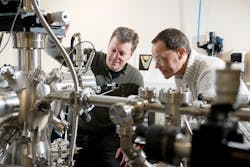The photoelectric effect, in which light impinging on certain materials causes emission of photoelectrons from the material, led Albert Einstein to hypothesize the quantization of the photon, earning him his only Nobel Prize. Now, two researchers at the University of Warwick (Coventry, England) have proposed a new type of photovoltaic cell based on the photoelectric effect.1
The cell would have a form similar to that of a thin double-glazed window, with inert gas filling the gap. The top vane would be a transparent anodic conductor, which the bottom would be coated with a photosensitive material that acts as photocathode, becoming a source of electrons (electrical current) under illumination by sunlight.
Now, to find the right photocathode
The optimal material for the photosensitive layer still needs to be identified, and the researchers have proposed a range of candidate materials, including thin films of diamond, which would be very robust and long-lasting. The transparency of the photocathode could be varied, leading to the possibility of tinted windows generating solar power.
RELATED: Five-junction photovoltaic cell has 44.5% efficiency
RELATED: No rare elements needed in novel solar-cell semiconductor zinc tin nitride
While the theoretical maximum efficiency of such a device is 57%, practical limitations, mainly the material properties of the anode and photocathode, would cause the actual efficiency to be lower.
The researchers would like the scientific community to think about potential optimal materials. "We think the materials challenge is really critical here so we wanted to encourage the materials science community to get creative," says Gavin Bell, a physicist at the University of Warwick. "Our device is radically different from standard photovoltaics, and can even be adapted for other green technologies such as turning heat directly into electricity, so we hope this work will inspire new advances."
Source: https://warwick.ac.uk/newsandevents/pressreleases/solar_power_advances/
REFERENCE:
1. Gavin R. Bell and Yorck A. Ramachers, Joule (2017); https://doi.org/10.1016/j.joule.2017.11.007

